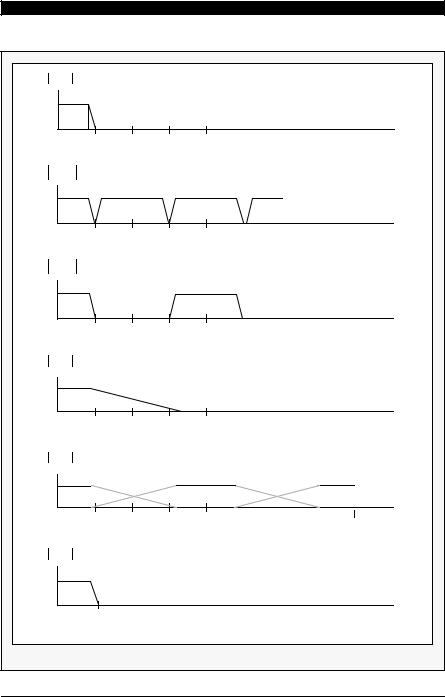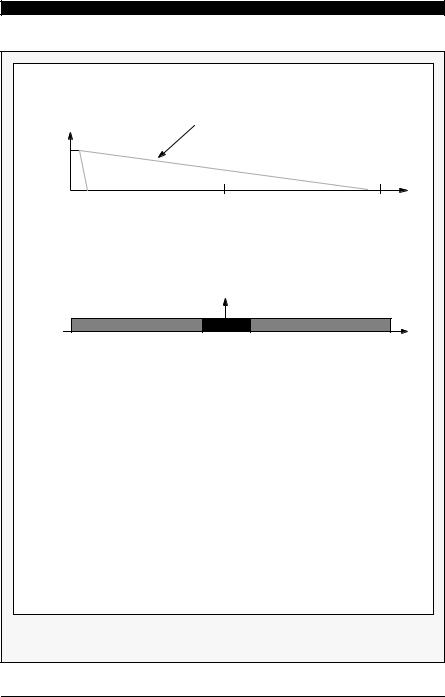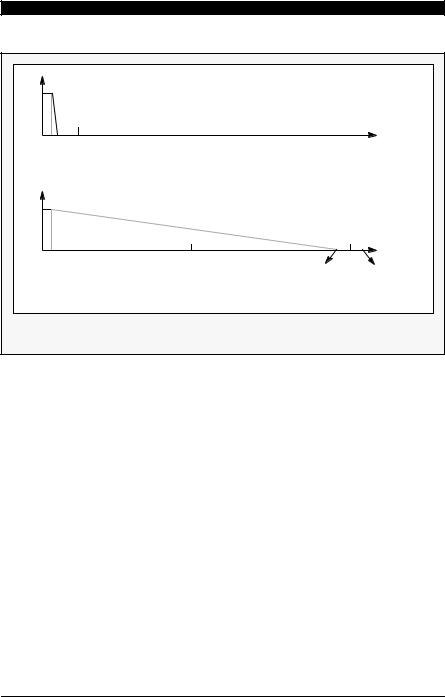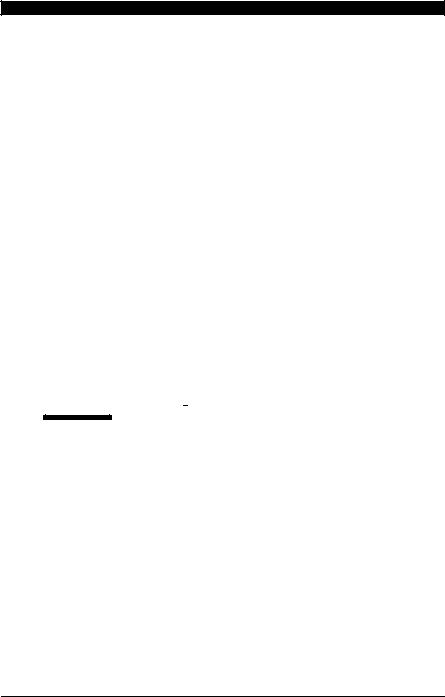

SECTION 4
“The benefit of oversampling is
more than an economical antialiasing filter. The decimation process can be used to provide increased resolution.”
Oversampling and
Decimation Basics
The quantization process in a Nyquist-rate A/D converter is generally different from that in an oversampling converter. While a Nyquist-rate A/D converter performs the quantization in a single sampling interval to the full precision of the converter, an oversampling converter generally uses a sequence of coarsely quantized data at the input oversampling rate of Fs = Nfs followed by a digital-domain decimation process to compute a more precise estimate for the analog input at the lower output sampling rate, fs, which is the same as used by the Nyquist samplers.
Regardless of the quantization process oversampling has immediate benefits for the anti-aliasing filter. To illustrate this point, consider a typical digital audio application using a Nyquist sampler and then using a two times oversampling approach. Note that in the following discussion the full precision of a Nyquist sampler is assumed. Coarse quantizers will be considered separately.
The data samples from Nyquist-rate converters are taken at a rate of at least twice the highest signal frequency of interest. For example, a 48 kHz sampling rate allows signals up to 24 kHz to pass without
MOTOROLA |
4-1 |

aliasing, but because of practical circuit limitation, the highest frequency that passes is actually about 22 kHz. Also, the anti-aliasing filter in Nyquist A/D converters requires a flat response with no phase distortion over the frequency band of interest (e.g., 20 kHz in digital audio applications). To prevent signal distortion due to aliasing, all signals above 24 kHz for a 48 kHz sampling rate must be attenuated by at least 96 dB for 16 bits of dynamic resolution.
These requirements are tough to meet with an analog low-pass filter. Figure 4-1(a) shows the required analog anti-aliasing filter response, while Figure 4-1(b) shows the digital domain frequency spectrum of the signal being sampled at 48 kHz.
Now consider the same audio signal sampled at 2fs, 96 kHz. The anti-aliasing filter only needs to eliminate signals above 74 kHz, while the filter has flat response up to 22 kHz. This is a much easier filter to build because the transition band can be 52 kHz (22k to 74 kHz) to reach the -96 dB point. However, since the final sampling rate is 48 kHz, a sample rate reduction filter, commonly called a decimation filter, is required but it is implemented in the digital domain, as opposed to anti-aliasing filters which are implemented with analog circuitry. Figure 4-1(d) and Figure 4-1(e) illustrate the analog anti-aliasing filter requirement and the digital-domain frequency response, respectively. The spectrum of a required digital decimation filter is shown in Figure 4-1(f). Details of the decimation process are discussed in
SECTION 7 Digital Decimation Filtering.
4-2 |
MOTOROLA |

H(f) |
|
|
|
|
|
22 k |
|
|
|
|
|
|
|
f |
|
24 k |
48 k |
72 k |
96 k |
H*(f) |
(a) |
Anti-aliasing filter response for Nyquist samplers |
||
|
|
|
|
|
|
24 k |
48 k |
72 k |
f |
|
96 k |
|||
H*(f) |
(b) Spectrum of sampled data when fs = 48 kHz |
|||
|
|
|
|
|
|
24 k |
48 k |
72 k |
f |
|
96 k |
|||
H(f) |
(c) Spectrum of sampled data when fs = 96 kHz |
|||
|
|
|
|
|
|
22 k |
|
|
|
|
. |
|
|
|
|
. |
|
|
|
|
. |
|
|
|
|
. |
|
|
|
|
. |
|
|
|
|
. |
|
|
|
|
. |
|
|
f |
|
24 k |
48 k |
72 k |
|
|
96 k |
|||
H(f) |
(d) |
Anti-aliasing filter response for 2x over-samplers |
||
|
|
|
|
|
|
22 k |
|
|
|
|
. |
|
|
|
|
. |
|
|
|
|
. |
|
|
|
|
. |
|
|
|
|
. |
|
|
|
|
. |
|
|
|
|
. |
|
|
f |
|
24 k |
48 k |
72 k |
|
|
96 k |
|||
|
|
|
|
192 k |
H(f) |
(e) Spectrum of 2x oversampled data when fs = 96 kHz |
|||
|
|
|
|
|
|
22.k |
|
|
|
|
. |
|
|
|
|
. |
|
|
|
|
. |
|
|
|
|
. |
|
|
|
|
. |
|
|
|
|
. |
|
|
f |
|
24 k |
|
|
|
|
|
|
|
|
|
(f) |
Digital filter response for 2:1 decimation process |
||
Figure 4-1 |
Comparison Between Nyquist Samplers and 2X Oversamples |
|||
MOTOROLA |
|
|
|
4-3 |

This two-times oversampling structure can be extended to N times oversampling converters. Figure 4-2(a) shows the frequency response of a general anti-alias- ing filter for N times oversamplers, while the spectra of overall quantization noise level and baseband noise level after the digital decimation filter is illustrated in Figure 4-2(b). Since a full precision quantizer was assumed, the total noise power for oversampling converters and one times Nyquist samplers are the same. However, the percentage of this noise that is in the bandwidth of interest, the baseband noise power NB is:
|
|
|
fB |
|
2fB q2 |
|
|
|
|
∫ |
(f)df = |
|
|
N |
B |
= |
------ ---- |
Eqn. 4-1 |
||
|
|
|
Fs 12 |
|
||
|
|
|
–fB |
|
|
|
which is much smaller (especially when Fs is much larger than fB) than the noise power of Nyquist samplers described in Eqn. 3-4.
Figure 4-3 compares the requirements of the antialiasing filter of one times and N times oversampled Nyquist rate A/D converters. Sampling at the Nyquist rate mandates the use of an anti-aliasing filter with very sharp transition in order to provide adequate aliasing protection without compromising the signal bandwidth fB .
4-4 |
MOTOROLA |

|
anti-aliasing filter’s frequency response |
||||
(a) |
|
|
|
|
|
|
fB |
Fs/2 |
|
Fs |
|
|
|
N(f) |
|
|
|
(b) |
|
|
|
|
|
- Fs/2 |
- fB |
fB |
|
Fs/2 |
|
|
Overall Noise Level: |
|
q2 |
1 |
|
|
N(f) = ------ |
----- |
|
||
|
|
|
12 |
Fs |
|
|
|
|
fB |
|
q2 |
|
In-Band Noise Level: |
NB = |
∫ N(f)df = |
fB 2 |
|
|
-------- ------ |
||||
|
|
|
–fB |
|
12 Fs |
|
|
|
|
|
|
Note: One R-C lowpass filter is sufficient for the anti-aliasing filter |
|||||
Figure 4-2 |
Anti-Aliasing Filter Response and Noise Spectrum of Oversampling |
||||
A/D Converters
MOTOROLA |
4-5 |

fN |
fs |
|
f |
(a) Nyquist rate A/D converters |
|
||
|
|
|
|
fB |
|
Fs/2 = fN |
Fs |
|
|
Fs - fB |
Fs + fB |
|
|
(b) Oversampling A/D converters |
|
Figure 4-3 Frequency Response of Analog Anti-Aliasing Filters
The transition band of the anti-aliasing filter of an oversampled A/D converter, on the other hand, is much wider than its passband, because anti-aliasing protection is required only for frequency bands between NFs –fB and NFs + fB , when N = 1, 2, ..., as shown in Figure 4-2(b). Since the complexity of the filter is a strong function of the ratio of the width of the transition band to the width of the passband, oversampled converters require considerably simpler anti-aliasing filters than Nyquist rate converters with similar performance. For example, with N = 64, a simple RC lowpass filter at the converter analog input is often sufficient as illustrated in Figure 4-2(a).
4-6 |
MOTOROLA |

The benefit of oversampling is more than an economical anti-aliasing filter. The decimation process can be used to provide increased resolution. To see how this is possible conceptually, refer to Figure 4-4, which shows an example of 16:1 decimation process with 1-bit input samples. Although the input data resolution is only 1-bit (0 or 1), the averaging method (decimation) yields more resolution (4 bits [24 = 16]) through reducing the sampling rate by 16:1. Of course, the price to be paid is high speed sampling at the input — speed is exchanged for resolution.
|
|
Sample Rate Reduction == >> More Resolution |
|
|||
1 |
|
|
|
|
|
|
|
|
|
|
|
||
0 |
|
|
|
|
|
|
1 |
|
|
|
|
|
|
0 |
|
|
|
|
|
|
0 |
|
|
|
|
|
|
1 |
|
|
16 : 1 decimation |
7 |
|
|
0 |
|
|
0111 |
|||
|
=================>> |
|||||
1 |
|
------ = 0.4375 = |
||||
|
|
average |
16 |
|
||
1 |
|
|
|
|
||
|
|
|
|
|
||
0 |
|
|
|
1 multi - bit output |
||
0 |
|
|
|
|||
|
|
|
|
|
||
0 |
|
|
|
|
|
|
1 |
|
|
|
|
|
|
0 |
|
|
|
|
|
|
1 |
|
|
|
|
|
|
|
|
|
|
|
||
|
16 1-bit inputs |
|
|
|||
|
|
|
|
|
|
|
Figure 4-4 Simple Example of Decimation Process
■
MOTOROLA |
4-7 |

“Delta
modulators,
furthermore, exhibit slope overload for rapidly rising input signals,
and their performance is thus dependent on the frequency of the input signal.”
SECTION 5
Delta Modulation
The work on sigma-delta modulation was developed as an extension to the well established delta modulation [6]. Let’s consider the delta modulation/ demodulation structure for the A/D conversion process. Figure 5-1 shows the block diagram of the delta modulator and demodulator. Delta modulation is based on quantizing the change in the signal from sample to sample rather than the absolute value of the signal at each sample.
Since the output of the integrator in the feedback loop of Figure 5-1(a) tries to predict the input x(t), the integrator works as a predictor. The prediction error term, x(t) –x(t) , in the current prediction is quantized and used to make the next prediction. The quantized prediction error (delta modulation output) is integrated in the receiver just as it is in the feed back loop [7]. That is, the receiver predicts the input signals as
shown in Figure 5-1.
The predicted signal is smoothed with a lowpass filter. Delta modulators, furthermore, exhibit slope overload for rapidly rising input signals, and their performance is thus dependent on the frequency of the input signal. In theory, the spectrum of quantization noise of the prediction error is flat and the noise level is set by the 1-bit comparator. Note that the signal-to-noise ratio can be enhanced by decimation processes as shown
MOTOROLA |
5-1 |
